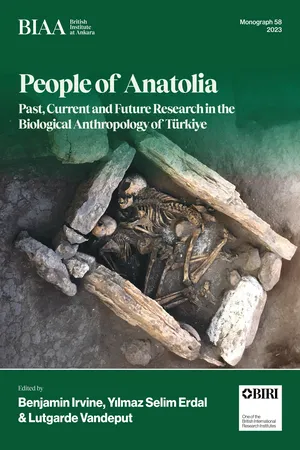
People of Anatolia
Past, Current and Future Research in the Biological Anthropology of Türkiye
- 132 pages
- English
- PDF
- Available on iOS & Android
People of Anatolia
Past, Current and Future Research in the Biological Anthropology of Türkiye
About this book
People of Anatolia: Past, Current and Future Research in the Biological Anthropology of Türkiye brings together, in one complete volume, some of the current research foci and trends of biological anthropology in Türkiye. The papers within this edited volume cover a multitude of topics, many of which complement and enhance each other, helping to demonstrate the strength and variety of research currently being performed in Türkiye by both domestic and foreign researchers. Furthermore, several of these papers examine large scale diachronic changes and highlight the importance of such holistic approaches and methodological considerations, and new trends in modern research by considering large scale patterns through time and space and the 'bigger' picture. For example, the application of multiple, more traditional macroscopic, biological anthropological analyses in conjunction with more modern techniques, such as biomolecular analyses. Biological anthropology in Türkiye has developed markedly since the days of primarily analyzing skeletal and dental morphometrics of the skeleton and investigating race. This is particularly true since the 1990s when studies have examined skeletal remains from Anatolia within wider bioarchaeological contexts and research questions. Research agendas have accelerated particularly in the last decade with the introduction and application of new methodologies, including quantifiable scientific techniques which has increased the ability to not only tackle existing and earlier research questions with more specificity and in more depth, but also enables us to tackle a greater variety of research questions, as well as stimulating new ones. This volume demonstrates how complementary, as well as large-scale diachronic studies enhance our knowledge not only of changes in human behavior and human-environment interactions through time, but also how these changes affected people at the individual, population, regional and pan-regional levels. One of the key messages from this edited volume, as a whole, is that multi-faceted and holistic approaches to exploring particular research agendas are both important and essential. While the individual papers in this volume may not necessarily always employ a multi-faceted or holistic approach, the combined reading of them does so. The types of data and information contained in the papers of this edited volume, therefore, will be of great interest and importance to the wider archaeological community in general. But particularly to Turkish students of archaeology, as well as Turkish/Türkiye-based and research focused archaeologists and specialists of biological anthropology and bioarchaeology and its sub-disciplines.
Frequently asked questions
- Essential is ideal for learners and professionals who enjoy exploring a wide range of subjects. Access the Essential Library with 800,000+ trusted titles and best-sellers across business, personal growth, and the humanities. Includes unlimited reading time and Standard Read Aloud voice.
- Complete: Perfect for advanced learners and researchers needing full, unrestricted access. Unlock 1.4M+ books across hundreds of subjects, including academic and specialized titles. The Complete Plan also includes advanced features like Premium Read Aloud and Research Assistant.
Please note we cannot support devices running on iOS 13 and Android 7 or earlier. Learn more about using the app.
Information
Table of contents
- Cover
- Title
- Copyright
- Contents
- List of figures
- List of tables
- 1. Introduction
- 2. Sex estimation and gender in ancient Anatolian populations
- 3. Stature estimation and stature changes in Anatolia
- 4. Re-evaluation of the prevalence of porotic hyperostosis in Anatolian populations by applying the ‘osteological paradox’ approach
- 5. Biological distance relations in Anatolian populations: an anthropological review
- 6. Intentional headshaping in Anatolia. A diachronic analysis of its typological and semantic distribution
- 7. A genomic history of Neolithisation in Anatolia: preliminary insights
- 8. The effects of agriculture on the human body: a case study of Anatolian Neolithic populations
- 9. Diachronic changes in the frequency of caries in Anatolian past populations
- 10. An isotopic perspective of diachronic changes in dietary habits and subsistence practices in Anatolia
- 11. Concluding remarks
- Index